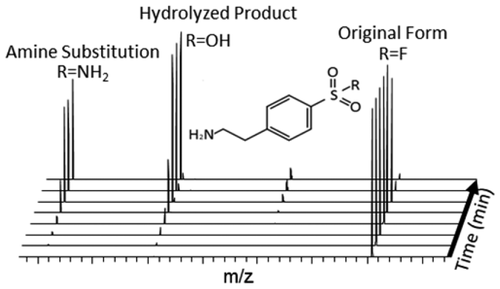当前位置:
X-MOL 学术
›
Anal. Chem.
›
论文详情
Our official English website, www.x-mol.net, welcomes your
feedback! (Note: you will need to create a separate account there.)
Hydrolysis-Kinetic Study of AEBSF, a Protease Inhibitor Used during Cell-Culture Processing of the HIV-1 Broadly Neutralizing Antibody CAP256-VRC25.26
Analytical Chemistry ( IF 6.7 ) Pub Date : 2018-03-06 00:00:00 , DOI: 10.1021/acs.analchem.7b05316 Jesse L Huang 1 , Attila Nagy 2 , Vera B Ivleva 2 , Daniel Blackstock 2 , Frank Arnold 2 , Cindy X Cai 2
Analytical Chemistry ( IF 6.7 ) Pub Date : 2018-03-06 00:00:00 , DOI: 10.1021/acs.analchem.7b05316 Jesse L Huang 1 , Attila Nagy 2 , Vera B Ivleva 2 , Daniel Blackstock 2 , Frank Arnold 2 , Cindy X Cai 2
Affiliation

|
One approach to mitigate product clipping during HIV mAb CAP256-VRC26.25 cell-culture development is the addition of the protease inhibitor 4-(2-aminoethyl) benzenesulfonyl fluoride (AEBSF) to the cell-culture media. AEBSF can undergo hydrolysis to form an inactive compound, 4-(2-aminoethyl) benzenesulfonic acid. Using mass-spectrometry detection, a kinetic profile of AEBSF hydrolysis was generated for conditions simulating those of cell culture at pH 7.0 and 37 °C. It was found that increasing the pH or the temperature could accelerate AEBSF hydrolysis. The kinetic-study results in this report provide an analytical characterization and guidance when optimizing an AEBSF-addition strategy for product-clipping control during cell-culture development and offer an alternative approach for AEBSF-related clearance studies post protein production.
中文翻译:

AEBSF(一种用于 HIV-1 广泛中和抗体 CAP256-VRC25.26 细胞培养处理过程中的蛋白酶抑制剂)的水解动力学研究
在 HIV mAb CAP256-VRC26.25 细胞培养开发过程中减轻产物剪切的一种方法是向细胞培养基中添加蛋白酶抑制剂 4-(2-氨基乙基) 苯磺酰氟 (AEBSF)。 AEBSF 可以水解形成惰性化合物 4-(2-氨基乙基)苯磺酸。使用质谱检测,在模拟 pH 7.0 和 37 °C 细胞培养条件下生成 AEBSF 水解动力学曲线。研究发现,提高pH值或温度可以加速AEBSF的水解。本报告中的动力学研究结果为优化细胞培养开发过程中产物剪切控制的 AEBSF 添加策略提供了分析表征和指导,并为蛋白质生产后 AEBSF 相关清除研究提供了另一种方法。
更新日期:2018-03-06
中文翻译:

AEBSF(一种用于 HIV-1 广泛中和抗体 CAP256-VRC25.26 细胞培养处理过程中的蛋白酶抑制剂)的水解动力学研究
在 HIV mAb CAP256-VRC26.25 细胞培养开发过程中减轻产物剪切的一种方法是向细胞培养基中添加蛋白酶抑制剂 4-(2-氨基乙基) 苯磺酰氟 (AEBSF)。 AEBSF 可以水解形成惰性化合物 4-(2-氨基乙基)苯磺酸。使用质谱检测,在模拟 pH 7.0 和 37 °C 细胞培养条件下生成 AEBSF 水解动力学曲线。研究发现,提高pH值或温度可以加速AEBSF的水解。本报告中的动力学研究结果为优化细胞培养开发过程中产物剪切控制的 AEBSF 添加策略提供了分析表征和指导,并为蛋白质生产后 AEBSF 相关清除研究提供了另一种方法。











































 京公网安备 11010802027423号
京公网安备 11010802027423号